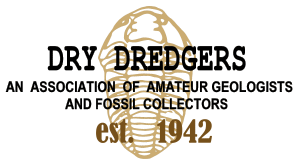A couple decades ago, the historic Lowell Laudon collection appeared on the fossil market. Lowell Laudon was a geologist who taught for 45 years at universities in Kansas and Wisconsin in the 1900s. He also was an avid field geologist, discovering and publishing on several classic Midwest crinoid sites. And in the process, he accumulated a mass of material that has been called his “bushels of fossils.”
I never met Lowell Laudon, but there is an interesting short story about him on the Internet. One of Laudon’s discoveries happened because he skipped out on a graduate class in geology in 1929. He did it to go visit his girlfriend Florence. But feeling guilty about missing the class, he and Florence went on a field trip to a nearby quarry. And they soon discovered the now famous Gilmore City echinoderm bed! Later that week, Florence and Lowell were engaged.
In addition to Gilmore City material, the Laudon collection was particularly noted for its Mississippian crinoids from LeGrand, Iowa. These specimens are renowned for the various colors and hues of the individual species, even for specimens adjacent to each other. Regrettably, I did not acquire one of those attractive crinoids in the brief time they were available. But I did purchase something else from the collection: an unprepared Mississippian starfish.
Only a very small fraction of the fossil was exposed on a thin limestone slab (none of the arms were exposed). But it looked promising enough to take a shot. Minutes after buying it at the MAPS Fossil Expo in Macomb, Illinois, I asked Scott Vergiels (also in attendance) if he would prep it. He wasn’t convinced the specimen would be complete (and neither was I), but he agreed to at least do exploratory prep. The following year at MAPS, Scott returned the rock to me. And surprise! The starfish was complete! See Figures 1 and 2.


There was some information that came with the slab:
- from the Laudon collection
- Mississippian
- Chester Series
- Hecker, Illinois
I heard that at one time there was a quarry in Hecker where echinoderms (such as blastoids) were found. Might that be the original source of this fossil? Does anyone have thoughts on identification of the starfish (genus, species) and the likely formation from which the slab might have come? Thanks in advance for any information.
Don Bissett

A long-time member of the Dry Dredgers, I’ve been collecting fossils ever since moving to Cincinnati in 1975 to work at P&G. I was introduced to fossil collecting by Bruce Gibson, another Dry Dredger and co-worker at P&G. Shortly after that, I met Dredger Dan Cooper. Both of them taught me a lot about the hobby. Ever since, I’ve been hooked on fossils.
My primary focus is collecting trilobites and echinoderms, though I often find myself accumulating a much wider assortment of fossils. Beyond the collecting hobby, I’ve also had the opportunity to work with professional paleontologists – extremely rewarding experiences. Some of those have been described in Dry Dredger Bulletin articles, MAPS (Mid-American Paleontology Society) articles, and technical publications. I plan to share more about collecting and professional interactions in my blog posts.Latest posts by Don Bissett (see all)
- Massie Shale Calymene - January 4, 2021
- Mississippian starfish - November 13, 2020
- Walcott-Rust Starfish - October 25, 2020
- Spathacalymene - September 20, 2020
- Penn Dixie Dig with the Experts 2018 - May 27, 2018





If it were Ordovician, I would say a species of Petraster.
So Petraster did not survive into the Mississippian?